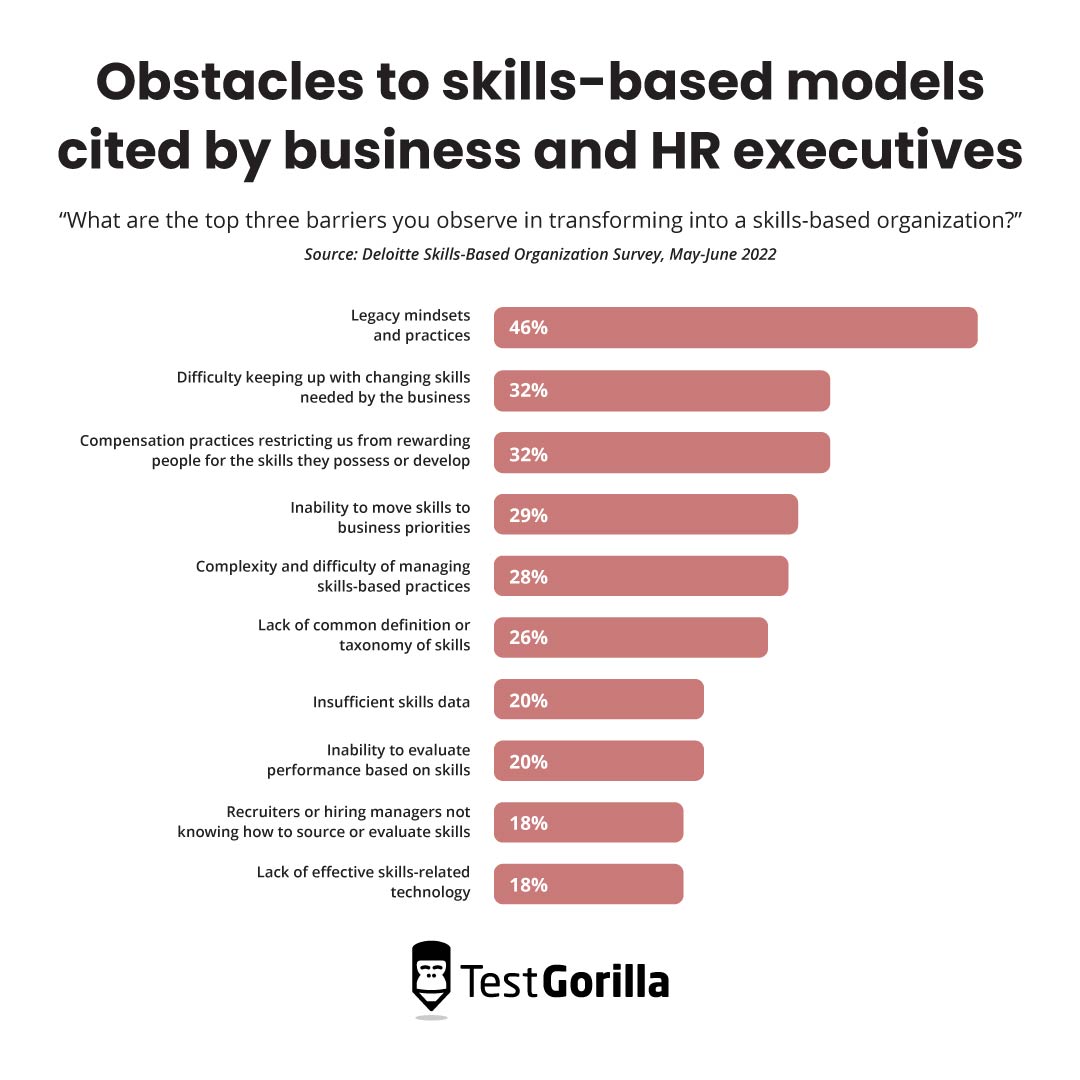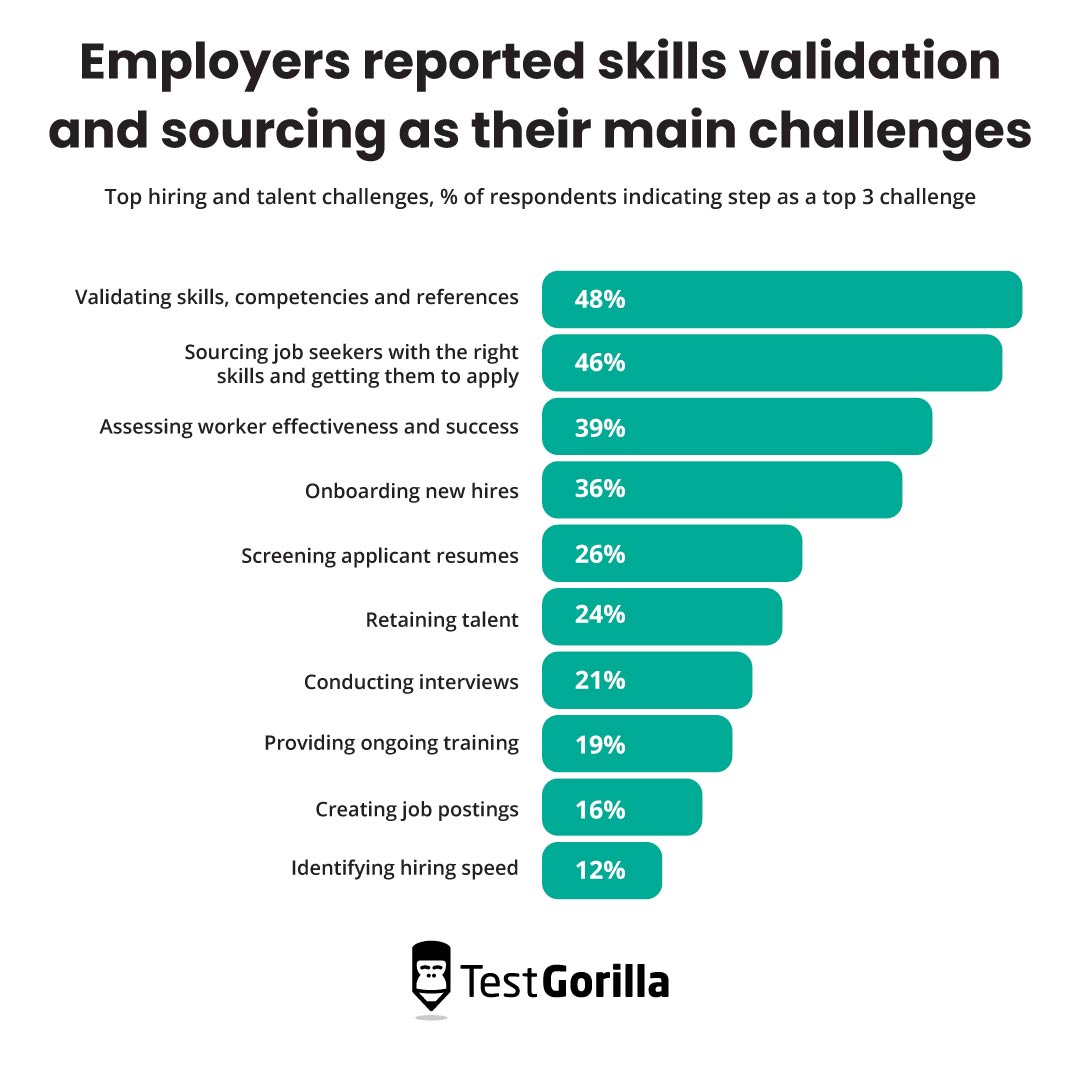Skills-based hiring is more widely applicable than you think
Can certain jobs possibly rely more on networking, relationship building, and other “soft skills” than demonstrable hard skills?
Yes. These positions do exist, and many hiring managers instinctively turn away from skills-based hiring when considering how to fill these roles.
Instead, they rely on traditional methods and their networks.
But is this the right hiring strategy?
The term “skills-based hiring” is much broader than most people think. You aren’t limited to testing job-dependent skills or other hard skills. Testing software also helps you test for soft skills like intuition, communication, and relationship-building – the building blocks to success in these soft-skill-oriented roles.
So yes, you can use skills-based hiring for these positions. This blog covers the details.
Table of contents
- The misconception preventing the adoption of skills-based hiring
- What modern skills testing actually looks like
- Does skills-based hiring work for leadership positions?
- Can skills testing be used to hire for manual labor?
- What about relationship-based roles?
- Moving beyond testing to create a skills-based organization
The misconception preventing the adoption of skills-based hiring
Whilst skills-based hiring is on the rise, many hiring managers still struggle to convince senior leadership to move away from legacy practices.
In a recent Deloitte study, HR executives shared their biggest barriers to transforming into a skills-based organization.
The top challenge?
The persistence of legacy mindsets and practices.
These legacy mindsets persist largely due to unfamiliarity with skills-based hiring: Many still think of skills testing too narrowly.
They understand the concept of skills assessment in the context of testing things like an applicant’s ability to code, write, or use a given piece of software.
These hard skills are the easiest kinds of tests to grasp for those who are unfamiliar with the extent to which skills testing can be applied. As such, common doubts and objections emerge:
“You can’t test whether I can install a new sink using an online assessment.”
“What skills are you testing for exactly if someone is applying for a job as a COO?”
“Soft skills like communication and leadership are more important than hard skills like those.”
But today’s skills tests can tackle a much broader range of assessments, enabling recruiters to test soft skills like leadership potential, work motivation styles, and communication skills.
All of this is great news for employers, who told McKinsey that their number one hiring and talent challenge is “validating skills, competencies, and references.”
What modern skills testing actually looks like
To understand what skills-based hiring looks like in modern organizations, we first need to recognize that the definition of “skills” in the context of work has changed.
Per Deloitte,
“We broadly define “skills” to encompass “hard” or technical skills (such as coding, data analysis, and accounting); human capabilities or human skills (such as critical thinking and emotional intelligence); and potential (including latent qualities, abilities, or adjacent skills that may be developed and lead to future success). Eventually, we see the word “skills” becoming short-hand for more granularly defining workers as unique, whole individuals—each with an array of skills, interests, passions, motivations, work or cultural styles, location preferences and needs, and more.”
The alteration to this definition outlined in this quote is necessary for several reasons.
First, it’s evident to many leaders that human capabilities like critical thinking, and inherent potential, such as latent abilities that can be developed and improved, are frequently more valuable than job-specific hard skills.
In many cases, hard skills can be taught on the job. Aspects of performance like people skills are a lot harder to instill in an employee.
More relevant to today’s work environment is the increasing automation of jobs that rely primarily on hard skills (such as manufacturing and transportation roles).
As a result, The Organization for Economic Cooperation and Development found that over the last 20 years, the percentage of “highly-skilled jobs” has increased by over 25%.
So the first step to implementing a successful skills-based hiring program is a change in mindset and a shift in how we define skills.
The second is to look at what the science has to say about skills testing in the context of work performance and to dispel the myth that skills assessments aren’t able to measure the less tangible side of the skills spectrum.
In a recent investigation into the validity of different hiring tools, we discuss recent advances in the assessment field that have reshaped our understanding of effective hiring practices. It's worth a read, but the main takeaway is this: In 2022, a new meta-analysis conducted by Sackett and colleagues (2022) was published. Sackett and colleagues (2022) found that structured interviews were the most predictive of overall job performance, followed by job knowledge tests and empirically keyed biodata.
These latest meta-analytic findings offer 6 key practical takeaways for hiring managers:
Combine multiple measures in the selection process
Use job-relevant hiring tools
Use structured interviews
Use job knowledge and skills tests
Use cognitive ability tests judiciously
When using personality and preference measures, match them to the role and context
As you can see, job relevancy and job knowledge are crucial to the most up-to-date guidance on ensuring hiring tool validity. Job relevancy and knowledge refer to all skill areas, not just the "hard" ones.
Let’s explore how skills-based hiring can be implemented in three areas that receive the highest degree of pushback from leaders struggling to understand the value of skills-based hiring.
Does skills-based hiring work for leadership positions?
Hiring for leadership positions is a high-stakes affair, especially when roughly half of management and executive hires don’t pan out.[1]
It’s reasonable, then, to be wary of any new approaches to hiring that fall outside of familiar and conventional boundaries (though it could also be argued that if half of your hires fail, you need to rethink your approach to candidate assessment).
The standard objections to using skills tests in the leadership hiring process are thus:
Leadership positions are mostly soft skill-based; charisma and people skills are the most important aspects of a good leader. You need real human interaction to assess that.
How does one assess “leadership capabilities” exactly?
Experience in previous positions is crucial for leadership success.
Well, let’s do a bit of debunking.
Yes, leadership positions are highly soft-skills-based. Although effective leaders need a firm knowledge of business and management principles, as well as a decent handle on how the industry works, soft skills like communication tend to be what separates great leaders from mediocre ones.
Daniel Goleman, psychologist, and author of the global bestselling book Emotional Intelligence (1995), believes that there are two primary abilities that create an effective leader:
Emotional intelligence (EQ): The ability to understand and manage your own emotions and to empathize with others.
Self-awareness: The ability to understand the reasons behind our own actions and to derive knowledge from those understandings.
But we’ve already learned that assessing soft skills like these is well within the realm of skills-based testing today.
Our own communication skills test assesses a candidate’s ability to:
Interpret non-verbal cues and listen actively
Use professional communication etiquette
Clarify next steps and summarize messages effectively
So, no, you don’t need face-to-face interaction alone to assess a candidate’s communication skills.
The same goes for test leadership capabilities.
Our leadership & people management test looks at an applicant’s ability to give constructive feedback, delegate tasks, support employee development, and gain buy-in for their plans and visions.
Such tests can be combined with personality assessments like the DISC test or Enneagram personality test to help you hire the right kind of leader for your current needs.
For example, if your organization needs a strategic leader, you might use the 16 personalities test to look for an INTJ or ENTJ type. If, however, you need someone to stir, motivate, and unite your employees, an ENFP or ESFP might be a better choice right now.
That just leaves one last objection to consider: the role of experience.
It seems obvious and intuitive that experience in a leadership role would create a better candidate, but Gautam Mukunda, Ph.D. and Research Fellow at the Center for Public Leadership at Harvard Kennedy School, found otherwise.
In a cross-disciplinary study of political, business, and military leaders, Mukunda discovered something interesting.[2]
Those with typical career paths and experience managing and leading teams (which he describes as “filtered leaders”) tend to deliver mediocre results.
Leaders who didn’t follow a normal progression (“unfiltered leaders”) skewed toward the extreme ends of the spectrum. They either flopped completely or outperformed their experienced counterparts.
In short, you have two options. Play it safe with an experienced manager, or run a high-risk, high-reward strategy by hiring an outsider.
The best approach, then, is to combine your understanding of an applicant’s workplace experience with leadership skills assessments to help you identify candidates with the precise skillsets you’re hiring for.
Can skills testing be used to hire for manual labor?
Manual labor positions like construction, plumbing, and electrical work are classic examples of roles that are underestimated when it comes to online skills testing.
Although it may be true that one can’t specifically test whether an applicant can put in a retaining wall or install a new shower unit with an online assessment, skills tests can be used to obtain a preliminary assessment of an applicant’s skill set.
Consider, for example, our Basic Electrical skills test, which assesses an applicant’s knowledge of:
Electric power
Electronic circuits
Digital logic design
Such tests can be used during the application process in addition to certification requirements, which, while important, don’t necessarily guarantee that an applicant has the specific knowledge to succeed in the position immediately.
Indeed, online assessments such as our Hospitality Skills test can be used to assess suitability for other blue-collar jobs.
Combining these role-specific assessments with personality and aptitude tests helps hiring managers to carry out effective candidate comparisons (recall what Schmidt and Hunter found about the predictive validity of combining these two assessment methods).
Moreover, using skills testing at this point in the manual labor recruitment process encourages you to make hiring decisions based on your ability to upskill and develop employees.
For instance, you might separate ‘necessary’ skills from ‘desired’ skills, where you have the ability to upskill the selected candidate if they fall short of some of the ‘desired’ skills.
What about relationship-based roles?
Many positions are heavy on relationship-building and customer service skills (sales, support, customer success, etc.)
Although hard skills are important for these roles – a customer support rep needs to understand how to use their support ticket portal – soft skills like communication and diplomacy are arguably more important.
Traditionally, hiring managers used college degrees as a proxy for the possession of such skills.
However, as recruiters face increasing pressure to combat degree inflation (the increasing requirement for degrees in job postings), they are removing such requirements and replacing them with a more detailed explanation of the soft skills necessary to excel.
According to McKinsey, employers like Boeing, IBM, and Walmart are intently focused on removing degree requirements from job postings that don’t require them and are increasingly embracing skills-based hiring methodologies.
So, how can one use skills testing to hire for such roles?
Let’s walk through an example process for hiring a sales rep.
As with the other positions mentioned above, work motivation, general mental aptitude, and sales-specific personality tests can all be used to identify whether applicants possess the characteristics you deem suitable for the role in question.
These tests are best used in conjunction with a structured interview that includes only predefined sales interview questions and role-specific skills tests that enable you to evaluate sales candidates on the basis of their current knowledge and expertise.
At TestGorilla, we’ve pre-designed several online skills assessments to help you hire for different customer-facing roles:
Account Executive (B2B Sales) test
Outside sales (B2B) skills test
B2C telesales test
B2B Lead Generation test
Retail Sales test
Moving beyond testing to create a skills-based organization
Although using skills testing as part of the hiring process is a valuable and important change, it’s just one component of a much wider business change: Becoming a skills-based organization.
Skills-based organizations seek to identify ways to break down traditional role-based siloes, empowering employees to move more freely between projects that match their skill sets.
Companies like Unilever are rethinking how work looks entirely:
“At Unilever… an internal talent marketplace enables skills to fluidly move to projects and tasks across the organization, either as a permanent employee or as a “U-Worker”: A worker who has a guaranteed minimum retainer along with a core set of benefits, and who contracts with Unilever for a series of short-term projects.”
Such developments are not only necessary for maximizing autonomy and employee welfare – two aspects of employment which are increasingly demanded by today’s workforce – but are key in driving organizational change.
Deloitte found that businesses that adopt a skills-based approach are:
107% more likely to place talent effectively
52% more likely to innovate
98% more likely to retain high-performers
To achieve such massive change, organizations like Unilever have had to rewrite the rulebook entirely.
That means throwing out some of your old assumptions and hiring practices and taking a second look at the application of skills testing in your recruitment process.
Ready to kick those old assumptions to the curb? Discover 4 habits you need to unlearn to use skills-based hiring effectively.
Sources
Sullivan, John. (April 10, 2017). “Ouch, 50% Of New Hires Fail! 6 Ugly Numbers Revealing Recruiting’s Dirty Little Secret”. DrJohnSullivan.Com. Retrieved March 7, 2023. https://drjohnsullivan.com/articles/hr-retention/ouch-50-new-hires-fail-6-ugly-numbers-revealing-recruitings-dirty-little-secret
Mukunda, Gautam. (October 2012). “Great Leaders Don’t Need Experience”. Harvard Business Review. Retrieved March 7, 2023. https://hbr.org/2012/10/great-leaders-dont-need-experience
Related posts
You've scrolled this far
Why not try TestGorilla for free, and see what happens when you put skills first.
Latest posts
The best insights on HR and recruitment, delivered to your inbox.
Biweekly updates. No spam. Unsubscribe any time.

Skills tests to hire the best
Our screening tests identify the best candidates and make your hiring decisions faster, easier, and bias-free.
Free resources
This handbook provides actionable insights, use cases, data, and tools to help you implement skills-based hiring for optimal success
A comprehensive guide packed with detailed strategies, timelines, and best practices — to help you build a seamless onboarding plan.
A comprehensive guide with in-depth comparisons, key features, and pricing details to help you choose the best talent assessment platform.
This in-depth guide includes tools, metrics, and a step-by-step plan for tracking and boosting your recruitment ROI.
A step-by-step blueprint that will help you maximize the benefits of skills-based hiring from faster time-to-hire to improved employee retention.
With our onboarding email templates, you'll reduce first-day jitters, boost confidence, and create a seamless experience for your new hires.
Get all the essentials of HR in one place! This cheat sheet covers KPIs, roles, talent acquisition, compliance, performance management, and more to boost your HR expertise.
Onboarding employees can be a challenge. This checklist provides detailed best practices broken down by days, weeks, and months after joining.
Track all the critical calculations that contribute to your recruitment process and find out how to optimize them with this cheat sheet.


















